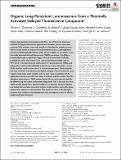Files in this item
Organic long persistent luminescence from a thermally activated delayed fluorescence compound
Item metadata
| dc.contributor.author | Li, Wenbo | |
| dc.contributor.author | Li, Zhaoning | |
| dc.contributor.author | Si, Changfeng | |
| dc.contributor.author | Wong, Michael Yin | |
| dc.contributor.author | Jinnai, Kazuya | |
| dc.contributor.author | Gupta, Abhishek Kumar | |
| dc.contributor.author | Kabe, Ryota | |
| dc.contributor.author | Adachi, Chihaya | |
| dc.contributor.author | Huang, Wei | |
| dc.contributor.author | Zysman-Colman, Eli | |
| dc.contributor.author | Samuel, Ifor David William | |
| dc.date.accessioned | 2020-10-08T10:30:05Z | |
| dc.date.available | 2020-10-08T10:30:05Z | |
| dc.date.issued | 2020-11-10 | |
| dc.identifier | 270005768 | |
| dc.identifier | 65b8beff-c6d0-4dde-9d4c-9cdf1ca1aef8 | |
| dc.identifier | 000575811400001 | |
| dc.identifier | 85092134701 | |
| dc.identifier.citation | Li , W , Li , Z , Si , C , Wong , M Y , Jinnai , K , Gupta , A K , Kabe , R , Adachi , C , Huang , W , Zysman-Colman , E & Samuel , I D W 2020 , ' Organic long persistent luminescence from a thermally activated delayed fluorescence compound ' , Advanced Materials , vol. 32 , no. 45 , 2003911 . https://doi.org/10.1002/adma.202003911 | en |
| dc.identifier.issn | 0935-9648 | |
| dc.identifier.other | ORCID: /0000-0001-7183-6022/work/81797763 | |
| dc.identifier.uri | https://hdl.handle.net/10023/20743 | |
| dc.description | Funding: UK EPSRC (grants EP/ P010482/1, EP/J01771X, EP/J00916, and EP/R035164/1). We gratefully acknowledge funding through the EPSRC NSFCBET lead agency agreement (EP/R010595/1,1706207) and a Leverhulme Trust Research Grant (RPG-2017-231). | en |
| dc.description.abstract | Organic long‐persistent luminescence (OLPL) is one of the most promising methods for long‐lived‐emission applications. However, present room‐temperature OLPL emitters are mainly based on a bimolecular exciplex system which usually needs an expensive small molecule such as 2,8‐bis(diphenyl‐phosphoryl)dibenzo[b,d]thiophene (PPT) as the acceptor. In this study, a new thermally activated delayed fluorescence (TADF) compound, 3‐(4‐(9H‐carbazol‐9‐yl)phenyl)acenaphtho[1,2‐b]pyrazine‐8,9‐dicarbonitrile (CzPhAP), is designed, which also shows OLPL in many well‐known hosts such as PPT, 2,2′,2″‐(1,3,5‐benzinetriyl)‐tris(1‐phenyl‐1‐H‐benzimidazole) (TPBi), and poly(methyl methacrylate) (PMMA), without any exciplex formation, and its OLPL duration reaches more than 1 h at room temperature. Combining the low cost of PMMA manufacture and flexible designs of TADF molecules, pure organic, large‐scale, color tunable, and low‐cost room‐temperature OLPL applications become possible. Moreover, it is found that the onset of the 77 K afterglow spectra from a TADF‐emitter‐doped film is not necessarily reliable for determining the lowest triplet state energy level. This is because in some TADF‐emitter‐doped films, optical excitation can generate charges (electron and holes) that can later recombine to form singlet excitons during the phosphorescence spectrum measurement. The spectrum taken in the phosphorescence time window at low temperature may consequently consist of both singlet and triplet emission. | |
| dc.format.extent | 9 | |
| dc.format.extent | 1594074 | |
| dc.language.iso | eng | |
| dc.relation.ispartof | Advanced Materials | en |
| dc.subject | Afterglow | en |
| dc.subject | Charge recombination | en |
| dc.subject | Charge separation | en |
| dc.subject | Long-persistent luminescence (LPL) | en |
| dc.subject | Organic long-persistent luminescence (OLPL) | en |
| dc.subject | Thermally activated delayed fluorescence (TADF) | en |
| dc.subject | QC Physics | en |
| dc.subject | TK Electrical engineering. Electronics Nuclear engineering | en |
| dc.subject | DAS | en |
| dc.subject.lcc | QC | en |
| dc.subject.lcc | TK | en |
| dc.title | Organic long persistent luminescence from a thermally activated delayed fluorescence compound | en |
| dc.type | Journal article | en |
| dc.contributor.sponsor | EPSRC | en |
| dc.contributor.sponsor | EPSRC | en |
| dc.contributor.sponsor | EPSRC | en |
| dc.contributor.sponsor | EPSRC | en |
| dc.contributor.sponsor | EPSRC | en |
| dc.contributor.institution | University of St Andrews. School of Physics and Astronomy | en |
| dc.contributor.institution | University of St Andrews. School of Chemistry | en |
| dc.contributor.institution | University of St Andrews. Centre for Biophotonics | en |
| dc.contributor.institution | University of St Andrews. Condensed Matter Physics | en |
| dc.contributor.institution | University of St Andrews. EaSTCHEM | en |
| dc.identifier.doi | 10.1002/adma.202003911 | |
| dc.description.status | Peer reviewed | en |
| dc.identifier.grantnumber | EP/P010482/1 | en |
| dc.identifier.grantnumber | EP/P010482/1 | en |
| dc.identifier.grantnumber | EP/J01771X/1 | en |
| dc.identifier.grantnumber | EP/R035164/1 | en |
| dc.identifier.grantnumber | EP/R035164/1 | en |
This item appears in the following Collection(s)
Items in the St Andrews Research Repository are protected by copyright, with all rights reserved, unless otherwise indicated.

